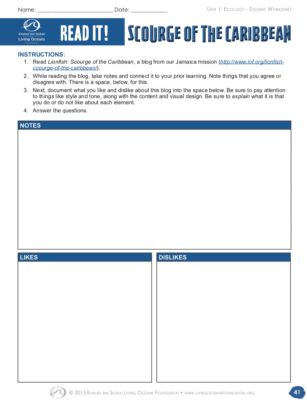Read It!

Scientists spend a lot of time reading and writing. Our scientists have written hundreds of field blogs about the coral reef research that we have conducted around the world. We have incorporated these blogs into our Coral Reef Ecology Curriculum. Each unit has one or more blogs associated with it and includes a corresponding Read It! worksheet.
Literacy is a component of K-12 science educational standards. Our blogs aid in increasing science literacy and help students interpret information, evaluate claims, and communicate clearly. The worksheets were designed for high school students; however, they may be appropriate for some middle schoolers. Below is a list of Read It! worksheets that include a short description of the blog.
Unit 1: Ecology
Scourge of the Caribbean
Lionfish are invading the Caribbean. Learn about the invasive lionfish and what people are doing to protect coral reefs in the Caribbean.
Unit 2: Classification
Troubling Taxonomy
Identifying coral is not an easy task. As described in the blog, our scientists use a variety of methods to identify corals.
Blue, You Say?
Sometimes we find something truly unique during our field expeditions. While on a mission in the South Pacific, we found an extraordinary coral called a Blue Coral (Heliopora coerulea). Discover its unusual properties and how it ended up on the endangered species list.
Unit 3: Coral Anatomy
Swimming Among Soft Corals
There are two main categories of corals – stony and soft. The author explains the differences between these two types of corals.
Unit 4: Coral Feeding
What’s on the Menu?
One of our colleagues researches the feeding habits of corals in New Caledonia, an island in the South Pacific. Unearth how her research could help understand coral resilience.
Unit 5: Coral Reproduction
Rolling Stones
Don’t be misled, this isn’t about the Rolling Stones band. It’s about a scientist who discovers an odd reproductive behavior of a Porites coral. Read this blog to find out more about coral reproduction and why he terms these corals “Rolling Stones.”
Unit 6: Life Cycle
Coral Recruitment
After corals mass spawn, how does the coral larvae know where they should settle and grow? Discover what one scientist’s research has revealed so far.
Unit 7: Distribution
Galapagos Ocean Currents
Why are the waters around the Galapagos Islands so rich with marine life? Here the currents not only dictate the climate, but also the ecology, both above and below the water. Learn how.
Unit 8: Environmental Conditions
Shivering for Science
How does temperature affect where corals live? Our mission to New Caledonia in the South Pacific provided a good laboratory to research this question. Find out why.
Unit 9: Coral Growth
Investigating the Reef Slope
How do coral growth forms vary with ocean depth? Learn about corals living along the reef slope and how their growth forms differ with depth.
Unit 10: Reef Types
Lagoon Reefs
Life can be difficult for corals living in a lagoon. Read about what our scientists discovered about the corals living in a French Polynesian lagoon.
Unit 11: Reef Zonation
Let’s Name the Zones
Two coral reefs (Raivavae and Tubuai) may have the same zonation pattern as other reefs in the area, but there were some very interesting findings that our scientists reported. Read more to explore why these reefs were so remarkable.
Additional Read It! Worksheets:
Coral Bleaching
Life and Death on the Reef
Coral bleaching can have devastating effects on a coral reef. Learn why one scientist is optimistic after observing a bleaching event while on our mission in the British Indian Ocean Territories (BIOT).
Crown-of-Thorns Starfish
Addressing Acanthaster
When the crown-of-thorns starfish (COTS) have population explosions, coral reefs are in real danger. What can we do to reduce this stress on coral reefs? Learn more about our SCAR program and what we are doing to address COTS.
Life, Death, and Rebirth
What caused the loss of the corals in French Polynesia? Read this two-part series to uncover what we found.
Overfishing
Best Wishes for Reef Fishes
Our scientists had workshops with local fishermen while we were on a mission in St. Kitts and Nevis in the Caribbean. Learn how working together can benefit all.
Sea Cucumber Craze
On our mission to Fiji in the South Pacific, we observed that there were very few sea cucumbers on the reefs. Discover more about how overfishing these “earthworms of the sea” can be detrimental to coral reefs and local communities.
The Man-Eaters
Wait, are there man-eaters in the ocean? Humans are the “man-eaters” in this scenario. Discover how one scientist in New Caledonia is studying giant clams to ensure their long-term survival.
General
General Read It! Worksheet
Did you find another blog that you like? This worksheet is not adapted for a specific blog; rather, it can be used with any of our blogs. Additional blogs can be found on our media webpage.